Business Future: Elements, Investor Evaluation, and Growth Factors
VerifiedAdded on 2020/11/12
|8
|1789
|182
Report
AI Summary
This report explores the various elements that are expected to shape the future of business, highlighting their impact on organizational strategies and investor perspectives. The report emphasizes the significance of both qualitative and quantitative factors in assessing business growth, including an analysis of business models, competitive advantages, and corporate governance. The role of value investors, such as Warren Buffett and Ben Graham, is discussed, along with their methodologies for identifying investment opportunities. The report also examines the importance of management quality and industry growth trends, such as cloud computing and cognitive computing, in driving future business success. The conclusion summarizes the findings, underscoring the need for businesses to adapt to future trends and leverage both qualitative and quantitative research for sustained success.

ELEMENTS DRIVING
FUTURE OF BUSINESS
FUTURE OF BUSINESS
Paraphrase This Document
Need a fresh take? Get an instant paraphrase of this document with our AI Paraphraser

CONTENTS
INTRODUCTION.........................................................................................................................................3
MAIN BODY.................................................................................................................................................3
CONCLUSION..............................................................................................................................................6
REFERENCES...............................................................................................................................................7
INTRODUCTION.........................................................................................................................................3
MAIN BODY.................................................................................................................................................3
CONCLUSION..............................................................................................................................................6
REFERENCES...............................................................................................................................................7
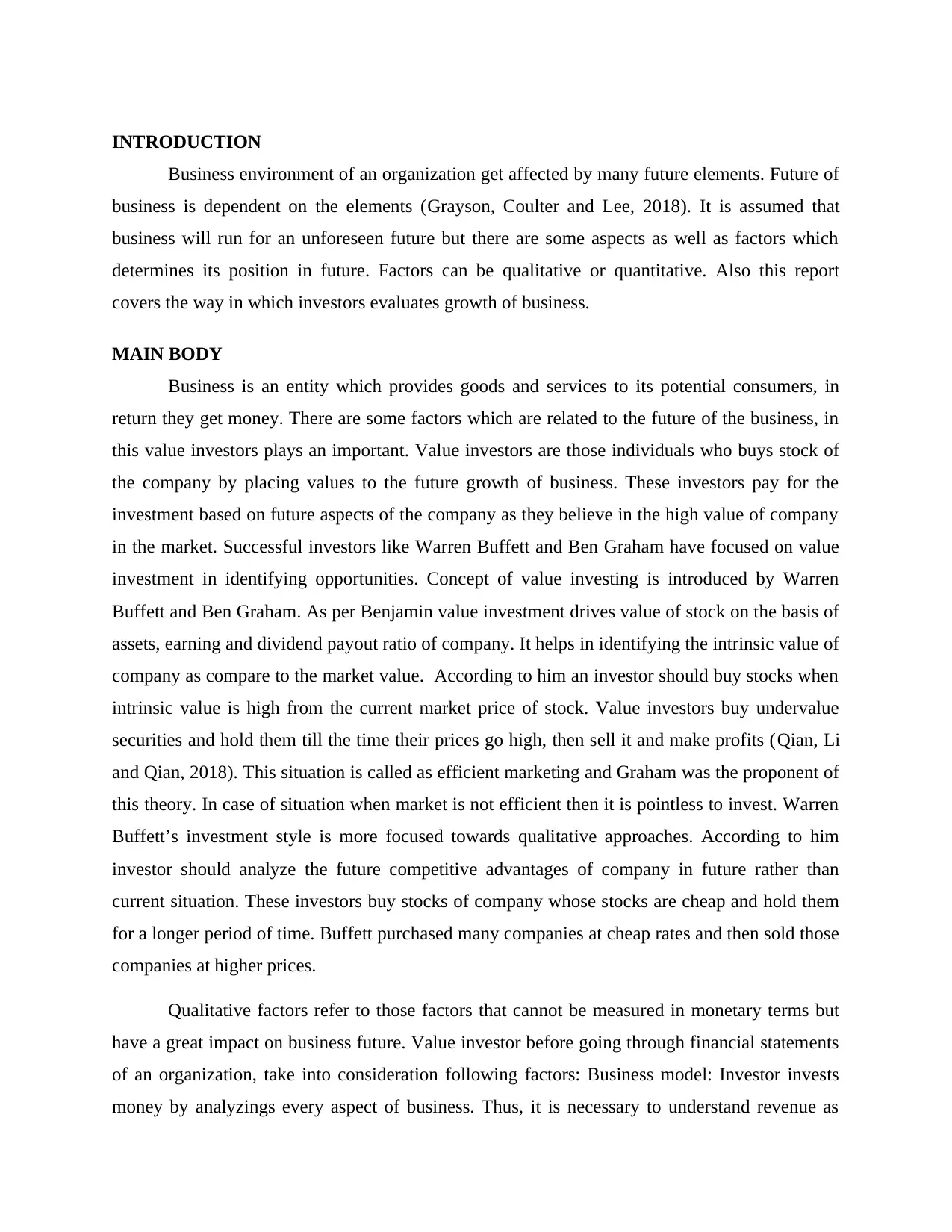
INTRODUCTION
Business environment of an organization get affected by many future elements. Future of
business is dependent on the elements (Grayson, Coulter and Lee, 2018). It is assumed that
business will run for an unforeseen future but there are some aspects as well as factors which
determines its position in future. Factors can be qualitative or quantitative. Also this report
covers the way in which investors evaluates growth of business.
MAIN BODY
Business is an entity which provides goods and services to its potential consumers, in
return they get money. There are some factors which are related to the future of the business, in
this value investors plays an important. Value investors are those individuals who buys stock of
the company by placing values to the future growth of business. These investors pay for the
investment based on future aspects of the company as they believe in the high value of company
in the market. Successful investors like Warren Buffett and Ben Graham have focused on value
investment in identifying opportunities. Concept of value investing is introduced by Warren
Buffett and Ben Graham. As per Benjamin value investment drives value of stock on the basis of
assets, earning and dividend payout ratio of company. It helps in identifying the intrinsic value of
company as compare to the market value. According to him an investor should buy stocks when
intrinsic value is high from the current market price of stock. Value investors buy undervalue
securities and hold them till the time their prices go high, then sell it and make profits (Qian, Li
and Qian, 2018). This situation is called as efficient marketing and Graham was the proponent of
this theory. In case of situation when market is not efficient then it is pointless to invest. Warren
Buffett’s investment style is more focused towards qualitative approaches. According to him
investor should analyze the future competitive advantages of company in future rather than
current situation. These investors buy stocks of company whose stocks are cheap and hold them
for a longer period of time. Buffett purchased many companies at cheap rates and then sold those
companies at higher prices.
Qualitative factors refer to those factors that cannot be measured in monetary terms but
have a great impact on business future. Value investor before going through financial statements
of an organization, take into consideration following factors: Business model: Investor invests
money by analyzings every aspect of business. Thus, it is necessary to understand revenue as
Business environment of an organization get affected by many future elements. Future of
business is dependent on the elements (Grayson, Coulter and Lee, 2018). It is assumed that
business will run for an unforeseen future but there are some aspects as well as factors which
determines its position in future. Factors can be qualitative or quantitative. Also this report
covers the way in which investors evaluates growth of business.
MAIN BODY
Business is an entity which provides goods and services to its potential consumers, in
return they get money. There are some factors which are related to the future of the business, in
this value investors plays an important. Value investors are those individuals who buys stock of
the company by placing values to the future growth of business. These investors pay for the
investment based on future aspects of the company as they believe in the high value of company
in the market. Successful investors like Warren Buffett and Ben Graham have focused on value
investment in identifying opportunities. Concept of value investing is introduced by Warren
Buffett and Ben Graham. As per Benjamin value investment drives value of stock on the basis of
assets, earning and dividend payout ratio of company. It helps in identifying the intrinsic value of
company as compare to the market value. According to him an investor should buy stocks when
intrinsic value is high from the current market price of stock. Value investors buy undervalue
securities and hold them till the time their prices go high, then sell it and make profits (Qian, Li
and Qian, 2018). This situation is called as efficient marketing and Graham was the proponent of
this theory. In case of situation when market is not efficient then it is pointless to invest. Warren
Buffett’s investment style is more focused towards qualitative approaches. According to him
investor should analyze the future competitive advantages of company in future rather than
current situation. These investors buy stocks of company whose stocks are cheap and hold them
for a longer period of time. Buffett purchased many companies at cheap rates and then sold those
companies at higher prices.
Qualitative factors refer to those factors that cannot be measured in monetary terms but
have a great impact on business future. Value investor before going through financial statements
of an organization, take into consideration following factors: Business model: Investor invests
money by analyzings every aspect of business. Thus, it is necessary to understand revenue as
⊘ This is a preview!⊘
Do you want full access?
Subscribe today to unlock all pages.

Trusted by 1+ million students worldwide
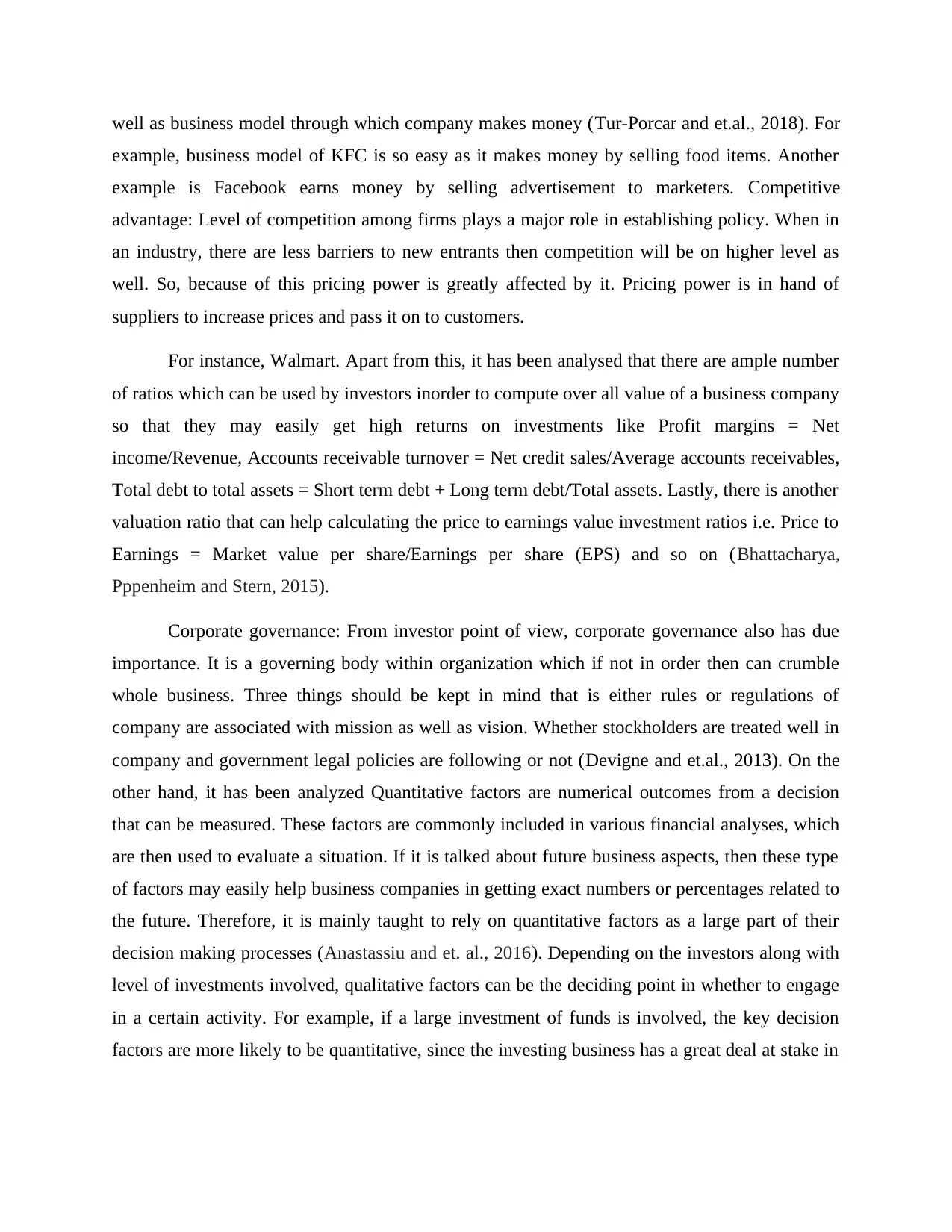
well as business model through which company makes money (Tur-Porcar and et.al., 2018). For
example, business model of KFC is so easy as it makes money by selling food items. Another
example is Facebook earns money by selling advertisement to marketers. Competitive
advantage: Level of competition among firms plays a major role in establishing policy. When in
an industry, there are less barriers to new entrants then competition will be on higher level as
well. So, because of this pricing power is greatly affected by it. Pricing power is in hand of
suppliers to increase prices and pass it on to customers.
For instance, Walmart. Apart from this, it has been analysed that there are ample number
of ratios which can be used by investors inorder to compute over all value of a business company
so that they may easily get high returns on investments like Profit margins = Net
income/Revenue, Accounts receivable turnover = Net credit sales/Average accounts receivables,
Total debt to total assets = Short term debt + Long term debt/Total assets. Lastly, there is another
valuation ratio that can help calculating the price to earnings value investment ratios i.e. Price to
Earnings = Market value per share/Earnings per share (EPS) and so on (Bhattacharya,
Pppenheim and Stern, 2015).
Corporate governance: From investor point of view, corporate governance also has due
importance. It is a governing body within organization which if not in order then can crumble
whole business. Three things should be kept in mind that is either rules or regulations of
company are associated with mission as well as vision. Whether stockholders are treated well in
company and government legal policies are following or not (Devigne and et.al., 2013). On the
other hand, it has been analyzed Quantitative factors are numerical outcomes from a decision
that can be measured. These factors are commonly included in various financial analyses, which
are then used to evaluate a situation. If it is talked about future business aspects, then these type
of factors may easily help business companies in getting exact numbers or percentages related to
the future. Therefore, it is mainly taught to rely on quantitative factors as a large part of their
decision making processes (Anastassiu and et. al., 2016). Depending on the investors along with
level of investments involved, qualitative factors can be the deciding point in whether to engage
in a certain activity. For example, if a large investment of funds is involved, the key decision
factors are more likely to be quantitative, since the investing business has a great deal at stake in
example, business model of KFC is so easy as it makes money by selling food items. Another
example is Facebook earns money by selling advertisement to marketers. Competitive
advantage: Level of competition among firms plays a major role in establishing policy. When in
an industry, there are less barriers to new entrants then competition will be on higher level as
well. So, because of this pricing power is greatly affected by it. Pricing power is in hand of
suppliers to increase prices and pass it on to customers.
For instance, Walmart. Apart from this, it has been analysed that there are ample number
of ratios which can be used by investors inorder to compute over all value of a business company
so that they may easily get high returns on investments like Profit margins = Net
income/Revenue, Accounts receivable turnover = Net credit sales/Average accounts receivables,
Total debt to total assets = Short term debt + Long term debt/Total assets. Lastly, there is another
valuation ratio that can help calculating the price to earnings value investment ratios i.e. Price to
Earnings = Market value per share/Earnings per share (EPS) and so on (Bhattacharya,
Pppenheim and Stern, 2015).
Corporate governance: From investor point of view, corporate governance also has due
importance. It is a governing body within organization which if not in order then can crumble
whole business. Three things should be kept in mind that is either rules or regulations of
company are associated with mission as well as vision. Whether stockholders are treated well in
company and government legal policies are following or not (Devigne and et.al., 2013). On the
other hand, it has been analyzed Quantitative factors are numerical outcomes from a decision
that can be measured. These factors are commonly included in various financial analyses, which
are then used to evaluate a situation. If it is talked about future business aspects, then these type
of factors may easily help business companies in getting exact numbers or percentages related to
the future. Therefore, it is mainly taught to rely on quantitative factors as a large part of their
decision making processes (Anastassiu and et. al., 2016). Depending on the investors along with
level of investments involved, qualitative factors can be the deciding point in whether to engage
in a certain activity. For example, if a large investment of funds is involved, the key decision
factors are more likely to be quantitative, since the investing business has a great deal at stake in
Paraphrase This Document
Need a fresh take? Get an instant paraphrase of this document with our AI Paraphraser
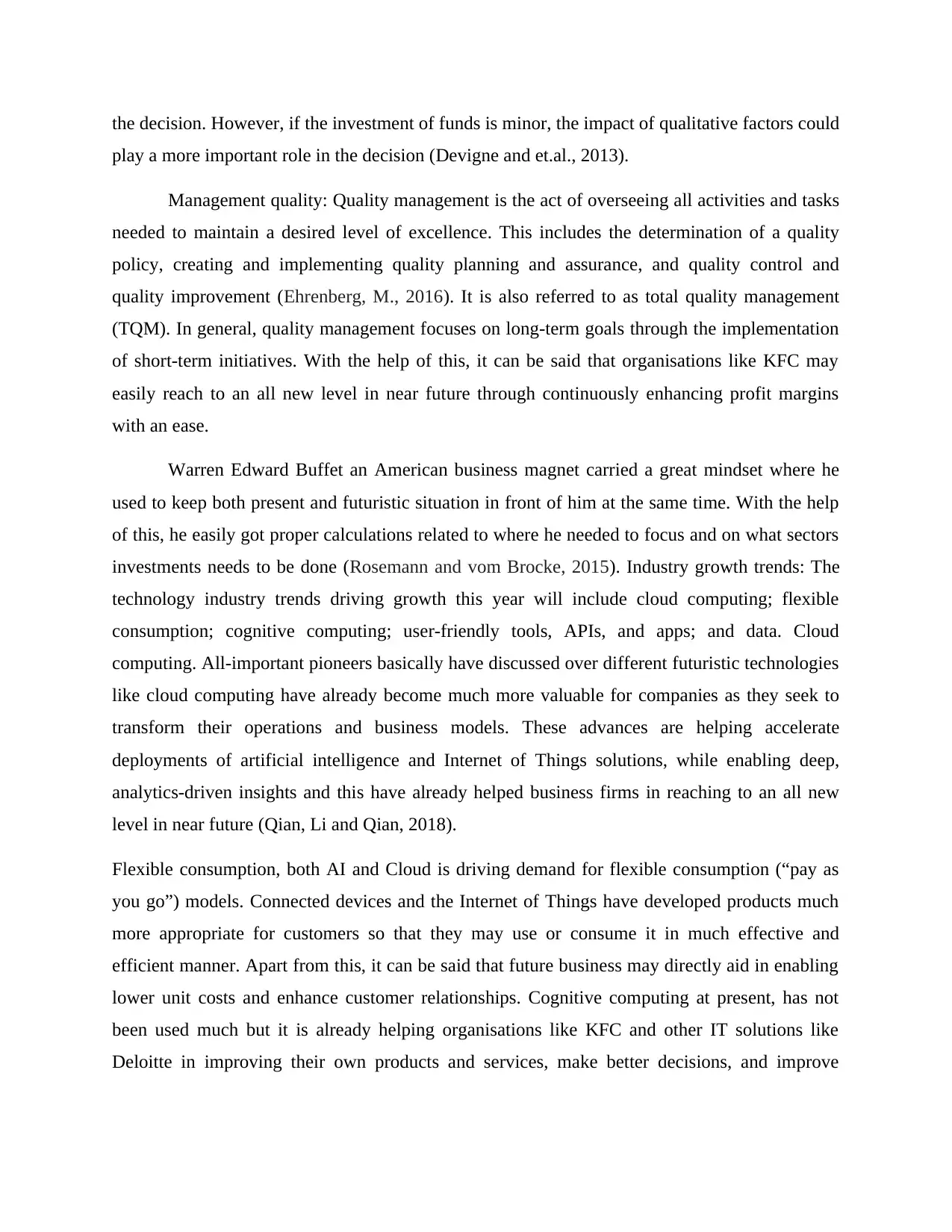
the decision. However, if the investment of funds is minor, the impact of qualitative factors could
play a more important role in the decision (Devigne and et.al., 2013).
Management quality: Quality management is the act of overseeing all activities and tasks
needed to maintain a desired level of excellence. This includes the determination of a quality
policy, creating and implementing quality planning and assurance, and quality control and
quality improvement (Ehrenberg, M., 2016). It is also referred to as total quality management
(TQM). In general, quality management focuses on long-term goals through the implementation
of short-term initiatives. With the help of this, it can be said that organisations like KFC may
easily reach to an all new level in near future through continuously enhancing profit margins
with an ease.
Warren Edward Buffet an American business magnet carried a great mindset where he
used to keep both present and futuristic situation in front of him at the same time. With the help
of this, he easily got proper calculations related to where he needed to focus and on what sectors
investments needs to be done (Rosemann and vom Brocke, 2015). Industry growth trends: The
technology industry trends driving growth this year will include cloud computing; flexible
consumption; cognitive computing; user-friendly tools, APIs, and apps; and data. Cloud
computing. All-important pioneers basically have discussed over different futuristic technologies
like cloud computing have already become much more valuable for companies as they seek to
transform their operations and business models. These advances are helping accelerate
deployments of artificial intelligence and Internet of Things solutions, while enabling deep,
analytics-driven insights and this have already helped business firms in reaching to an all new
level in near future (Qian, Li and Qian, 2018).
Flexible consumption, both AI and Cloud is driving demand for flexible consumption (“pay as
you go”) models. Connected devices and the Internet of Things have developed products much
more appropriate for customers so that they may use or consume it in much effective and
efficient manner. Apart from this, it can be said that future business may directly aid in enabling
lower unit costs and enhance customer relationships. Cognitive computing at present, has not
been used much but it is already helping organisations like KFC and other IT solutions like
Deloitte in improving their own products and services, make better decisions, and improve
play a more important role in the decision (Devigne and et.al., 2013).
Management quality: Quality management is the act of overseeing all activities and tasks
needed to maintain a desired level of excellence. This includes the determination of a quality
policy, creating and implementing quality planning and assurance, and quality control and
quality improvement (Ehrenberg, M., 2016). It is also referred to as total quality management
(TQM). In general, quality management focuses on long-term goals through the implementation
of short-term initiatives. With the help of this, it can be said that organisations like KFC may
easily reach to an all new level in near future through continuously enhancing profit margins
with an ease.
Warren Edward Buffet an American business magnet carried a great mindset where he
used to keep both present and futuristic situation in front of him at the same time. With the help
of this, he easily got proper calculations related to where he needed to focus and on what sectors
investments needs to be done (Rosemann and vom Brocke, 2015). Industry growth trends: The
technology industry trends driving growth this year will include cloud computing; flexible
consumption; cognitive computing; user-friendly tools, APIs, and apps; and data. Cloud
computing. All-important pioneers basically have discussed over different futuristic technologies
like cloud computing have already become much more valuable for companies as they seek to
transform their operations and business models. These advances are helping accelerate
deployments of artificial intelligence and Internet of Things solutions, while enabling deep,
analytics-driven insights and this have already helped business firms in reaching to an all new
level in near future (Qian, Li and Qian, 2018).
Flexible consumption, both AI and Cloud is driving demand for flexible consumption (“pay as
you go”) models. Connected devices and the Internet of Things have developed products much
more appropriate for customers so that they may use or consume it in much effective and
efficient manner. Apart from this, it can be said that future business may directly aid in enabling
lower unit costs and enhance customer relationships. Cognitive computing at present, has not
been used much but it is already helping organisations like KFC and other IT solutions like
Deloitte in improving their own products and services, make better decisions, and improve
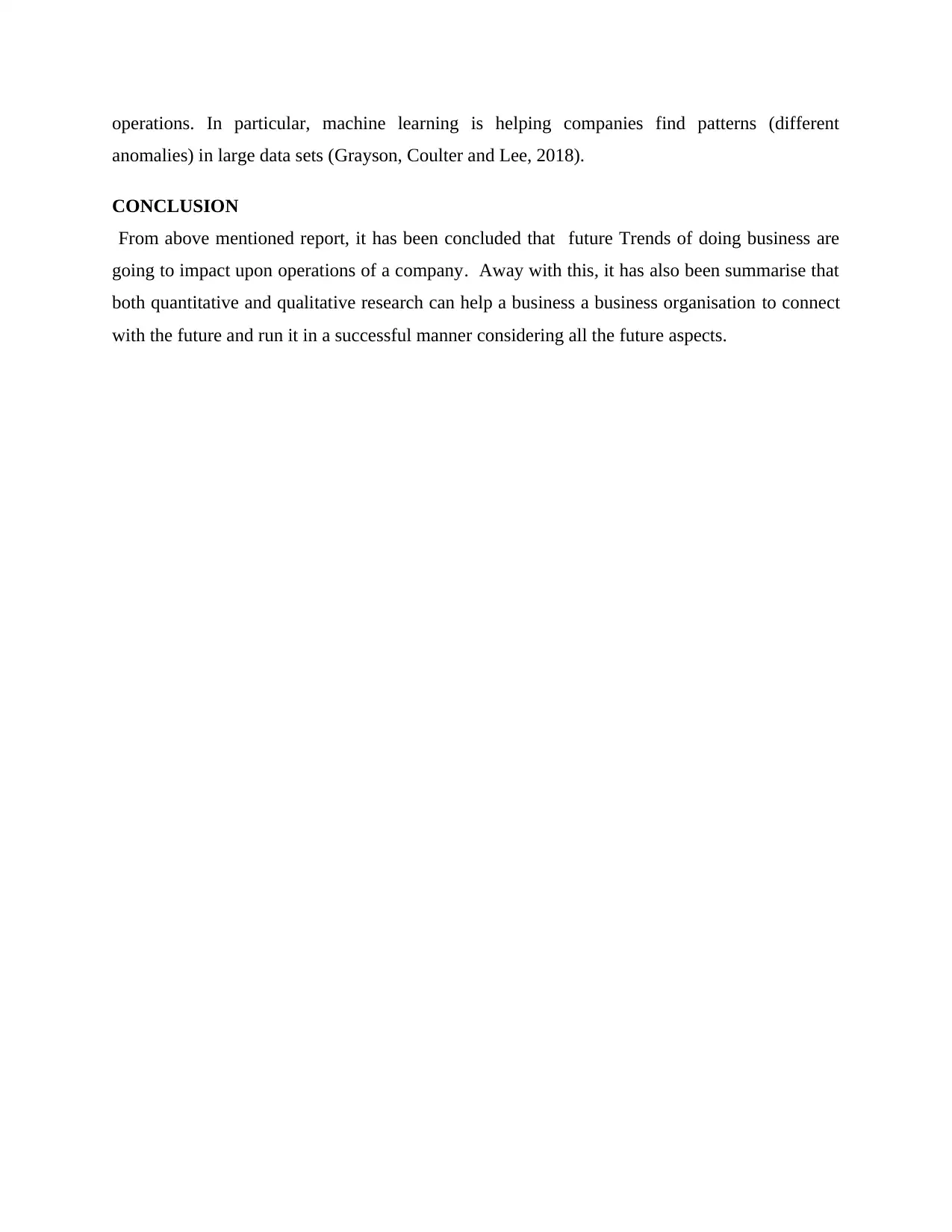
operations. In particular, machine learning is helping companies find patterns (different
anomalies) in large data sets (Grayson, Coulter and Lee, 2018).
CONCLUSION
From above mentioned report, it has been concluded that future Trends of doing business are
going to impact upon operations of a company. Away with this, it has also been summarise that
both quantitative and qualitative research can help a business a business organisation to connect
with the future and run it in a successful manner considering all the future aspects.
anomalies) in large data sets (Grayson, Coulter and Lee, 2018).
CONCLUSION
From above mentioned report, it has been concluded that future Trends of doing business are
going to impact upon operations of a company. Away with this, it has also been summarise that
both quantitative and qualitative research can help a business a business organisation to connect
with the future and run it in a successful manner considering all the future aspects.
⊘ This is a preview!⊘
Do you want full access?
Subscribe today to unlock all pages.

Trusted by 1+ million students worldwide
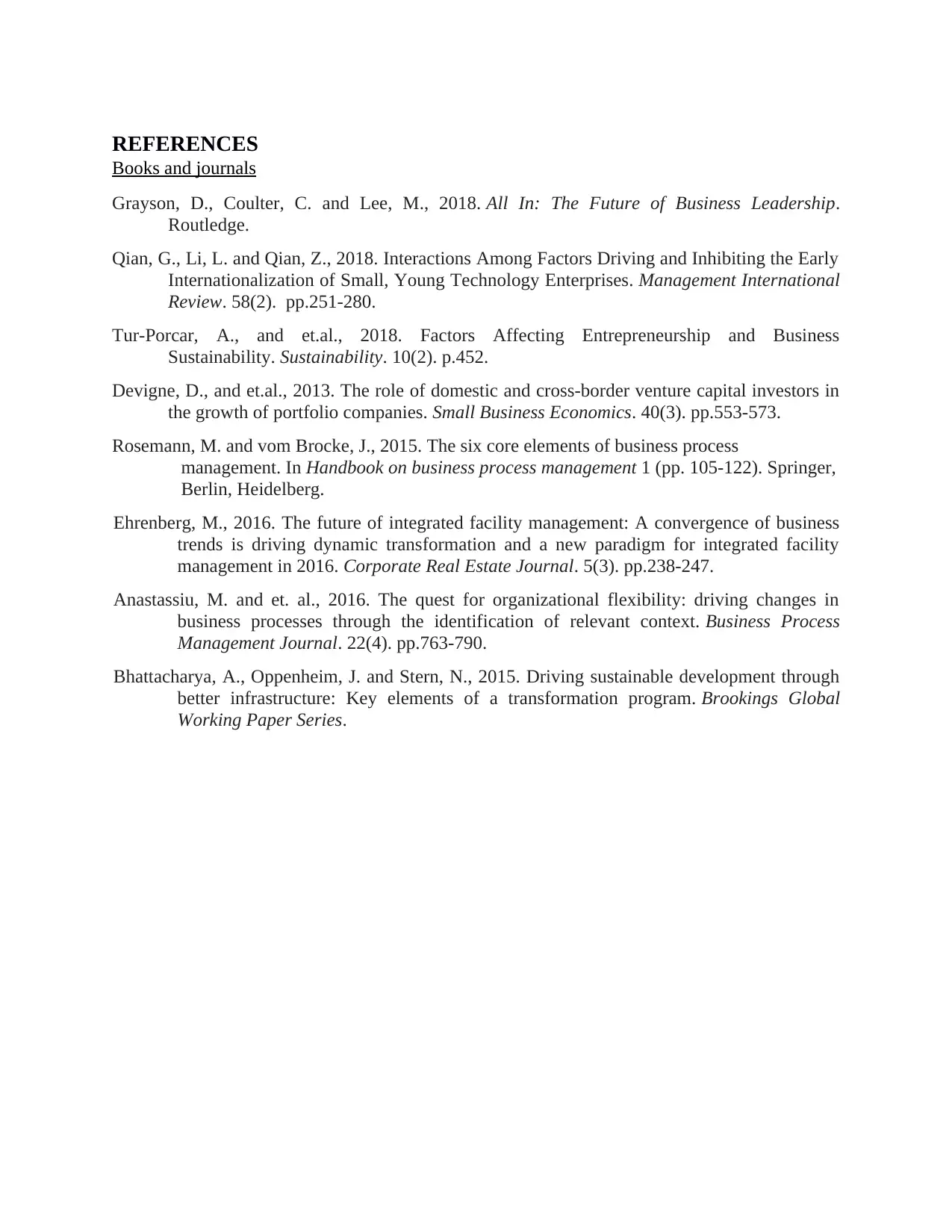
REFERENCES
Books and journals
Grayson, D., Coulter, C. and Lee, M., 2018. All In: The Future of Business Leadership.
Routledge.
Qian, G., Li, L. and Qian, Z., 2018. Interactions Among Factors Driving and Inhibiting the Early
Internationalization of Small, Young Technology Enterprises. Management International
Review. 58(2). pp.251-280.
Tur-Porcar, A., and et.al., 2018. Factors Affecting Entrepreneurship and Business
Sustainability. Sustainability. 10(2). p.452.
Devigne, D., and et.al., 2013. The role of domestic and cross-border venture capital investors in
the growth of portfolio companies. Small Business Economics. 40(3). pp.553-573.
Rosemann, M. and vom Brocke, J., 2015. The six core elements of business process
management. In Handbook on business process management 1 (pp. 105-122). Springer,
Berlin, Heidelberg.
Ehrenberg, M., 2016. The future of integrated facility management: A convergence of business
trends is driving dynamic transformation and a new paradigm for integrated facility
management in 2016. Corporate Real Estate Journal. 5(3). pp.238-247.
Anastassiu, M. and et. al., 2016. The quest for organizational flexibility: driving changes in
business processes through the identification of relevant context. Business Process
Management Journal. 22(4). pp.763-790.
Bhattacharya, A., Oppenheim, J. and Stern, N., 2015. Driving sustainable development through
better infrastructure: Key elements of a transformation program. Brookings Global
Working Paper Series.
Books and journals
Grayson, D., Coulter, C. and Lee, M., 2018. All In: The Future of Business Leadership.
Routledge.
Qian, G., Li, L. and Qian, Z., 2018. Interactions Among Factors Driving and Inhibiting the Early
Internationalization of Small, Young Technology Enterprises. Management International
Review. 58(2). pp.251-280.
Tur-Porcar, A., and et.al., 2018. Factors Affecting Entrepreneurship and Business
Sustainability. Sustainability. 10(2). p.452.
Devigne, D., and et.al., 2013. The role of domestic and cross-border venture capital investors in
the growth of portfolio companies. Small Business Economics. 40(3). pp.553-573.
Rosemann, M. and vom Brocke, J., 2015. The six core elements of business process
management. In Handbook on business process management 1 (pp. 105-122). Springer,
Berlin, Heidelberg.
Ehrenberg, M., 2016. The future of integrated facility management: A convergence of business
trends is driving dynamic transformation and a new paradigm for integrated facility
management in 2016. Corporate Real Estate Journal. 5(3). pp.238-247.
Anastassiu, M. and et. al., 2016. The quest for organizational flexibility: driving changes in
business processes through the identification of relevant context. Business Process
Management Journal. 22(4). pp.763-790.
Bhattacharya, A., Oppenheim, J. and Stern, N., 2015. Driving sustainable development through
better infrastructure: Key elements of a transformation program. Brookings Global
Working Paper Series.
Paraphrase This Document
Need a fresh take? Get an instant paraphrase of this document with our AI Paraphraser

1 out of 8
Related Documents
Your All-in-One AI-Powered Toolkit for Academic Success.
+13062052269
info@desklib.com
Available 24*7 on WhatsApp / Email
![[object Object]](/_next/static/media/star-bottom.7253800d.svg)
Unlock your academic potential
Copyright © 2020–2025 A2Z Services. All Rights Reserved. Developed and managed by ZUCOL.





